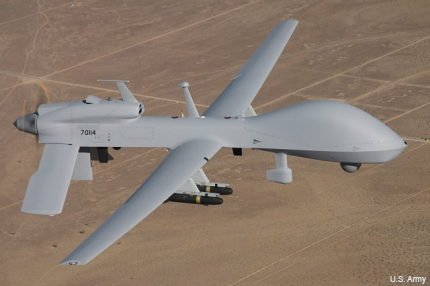Making civilian skies safe for unmanned aircraft
How the Army is working with the FAA and other military services to prevent drone collisions with other aircraft.

As unmanned aerial systems increasingly impinge on the national airspace, and near misses between drones and commercial aircraft provide extra impetus, the Defense Department, Federal Aviation Administration and other stakeholders are scrambling for better radar and other “separation” tools for keeping them out of each other’s way.
“Sense-and-avoid,” or SAA, technology is the key to meeting FAA requirements for domestic use of UAS.
One innovative approach embodying it is the Army’s new Ground-Based Sense-and-Avoid radar system, or GBSAA.
The system was delivered in mid-December to Fort Hood, Texas, for testing with resident Gray Eagle UAS. It’s mounted atop an open framework tower calling to mind a forest ranger’s observation post. The Army is planning to install GBSAA at four other locations, to accommodate the movement of UAS from airfields to restricted areas for training and testing.
Overseeing GBSSA is Viva Kelley, product director for Army Unmanned Aircraft Systems Airspace Integration Concepts. Kelley discussed recent developments with Defense Systems via email.
DS: With Army, Navy and Air Force working along similar sense-and-avoid lines, will there emerge a common operating or enabling tool or component?
Kelley: We can't comment on [Air Force] or Navy SAA systems, but we are working with the AF ABSAA (airborne-based) SAA program office to develop as much commonality as possible at this stage. We currently have a Common Display Integrated Product Team working that effort for the Army and the AF is using both our existing GBSAA display requirements and some of the AF's.
DS: Different estimates are being heard for when Army’s system may go active/real-time operational at Fort Hood. Some speak of beyond the projected 2015. What’s the current timeline?
Kelley: We are still on track to be operational at Fort Hood in calendar year 2015. The other sites follow in series about every few months after one another. We are already prepping all sites.
DS: Typically, ground observers and chase trucks eye the skies to manage deconfliction of manned and unmanned aircraft. Is Army GBSAA - or technologically similar ABSSA - a major improvement or an incremental step?
Kelley: Both. The Army's GBSAA system is designed and developed as a safety-critical system and is an improvement on safety and operational capability.
However, we expect that over time, SAA will grow and mature and so we have built our system with an open architecture that allows for expansion, growth in technology/sensors, growth in operational needs, etc. [And again], we are coordinating with the Air Force to help build systems that can be operated together.
DS: Decisions on ground-based or airborne variants seem related to the operating environment, urban or countryside, plus altitudes and size of the unmanned vehicle. What is your system’s tasking?
Kelley: The Army's system has been designed and developed to support operations in any airspace under any concept. It was designed for use with aircraft that cannot support large onboard systems, but it could be used with any aircraft. It is (truly) a system allowing you to separate yourself (“ownship”) from other aircraft.
DS: What are the prime pieces?
Kelley: Besides 3D radar, it has subsystems which perform the functions of fusion tracker (developed specifically for this system; optimized for the assess and maneuver algorithms), classify (distinguishes birds, radar clutter, etc. from aircraft), data management, health and integrity monitoring of all subsystems, and displays.
DS: any thoughts given to redundancy?
Kelley: There are extensive failover architectures for the system, and everything is hosted on an open architecture data distribution service. Many of these specifically designed subsystems, and the fact that they are calculated around the ownship of the aircraft using the GBSAA, distinguish the Army system.
DS: How goes collaboration with the FAA, Congress, airport authorities, contractors and other stakeholders?
Kelley: DOD uses an Executive Committee to interface with the FAA. The Army interfaces with airport authorities at sites where we are fielding, to minimize any change to their current procedures. This is done when we conduct site surveys, etc.
DS: How did core competencies come to pass?
Kelley: The system’s algorithms were developed from ACAS-X (FAA-funded research and development of a new approach to airborne collision avoidance, based on TCAS – the Traffic Collision Avoidance System). This and the fact that the algorithms currently only consider horizontal maneuvers makes us inherently compatible with TCAS. The system/algorithms were designed with the "rules of the road" in mind and the GBSAA operators are trained in standard civil practices.
Also, we are currently taking advantage of open architecture design by also using local Air Traffic Control radar and transponding information from them.
DS: In sum, what is the main advantage over prior or extant aircraft-separation modes?
Kelley: The beauty of the Army GBSAA is that it pays particular attention to those aircraft which are not transponding or coordinating with Air Traffic Control. These tend to be the most worrisome, as many times Air Traffic Control has no way of knowing they are there or tracking them.
David C. Walsh is a freelance writer covering defense IT.
NEXT STORY: 7 breakthrough technologies from 2014



